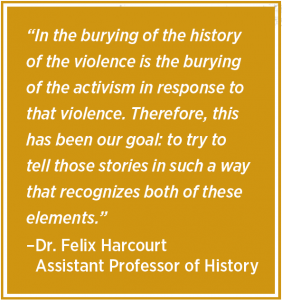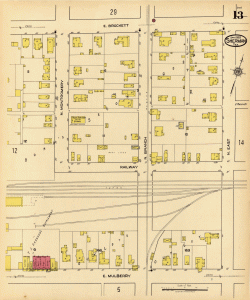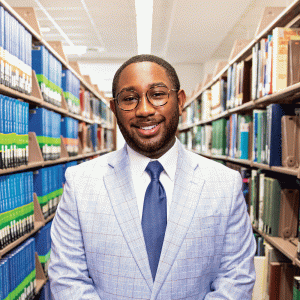 How Austin College is Recovering Local History
How Austin College is Recovering Local History
By Leslie Whelan, Contributing Writer
Austin College alumni have traveled down Brockett Street countless times; through campus, over railroad tracks, and past homes and businesses—including the former home of a prominent Sherman resident of the last century. The dwelling at 314 East Brockett Street bears no indication that attorney William J. Durham (1896- 1970) once lived here. One of few African American attorneys in Texas in the early twentieth century, Durham collaborated with future Supreme Court Justice Thurgood Marshall to win the case Sweatt v. Painter that successfully integrated the University of Texas School of Law by challenging the “separate but equal” doctrine. That court decision served as a key precedent in the later Supreme Court ruling, Brown v. Board of Education, that struck down segregation in public schools.
Thanks to the work of Austin College students and faculty, local awareness of Durham’s historical significance is growing. The Social Justice Walking Tour, developed in 2018 and currently led by Assistant Professor of History Dr. Felix Harcourt, illuminates otherwise forgotten Sherman landmarks such as Durham’s house and the former site of Sherman’s lost Black business district. Ninety years ago, the G.W. Andrews Building was the hub of this once-thriving three blocks of businesses and professional offices; Durham practiced law there. In 1930, however, life in Sherman took an unexpected and grim turn.

On May 3 of that year, a Black Grayson County resident named George Hughes was accused of assaulting a white woman and was arrested. Fearing that a mob would lynch Hughes, the Grayson County Sheriff sent him out of town until his trial. During his May 9 trial, 5,000 people filled the Grayson County Courthouse square demanding that Hughes be handed over. The prisoner was sheltered in a vault, but the mob set the Courthouse on fire, and Hughes did not survive as the building was consumed in flames. The mob retrieved Hughes’ body and dragged it four blocks to the Black business district, then burned down the G.W. Andrews building and surrounding businesses and homes. Only one rioter was convicted for arson; no one for lynching.
Durham’s office was gone, but he stayed in Sherman until 1943, eventually moving to Dallas to continue a long and distinguished career. Yet, little is known about his life in Sherman because his community was destroyed. Many Black residents fled after the riot, and while the courthouse was built anew, the Black business district was never rebuilt. The 1930 riot had made international headlines, but regional efforts to preserve accounts of what happened were sparse. Then, once again, a tragic event altered the status quo. In 2020, the death of George Floyd at the hand of police in Minnesota stirred local citizens and community leaders to re-examine and explore their own history; Austin College has had the opportunity to contribute to these efforts.
Uncovering Forgotten Stories
After his initial involvement with the Social Justice Walking Tour, Harcourt says, “I wanted to think about ways that we could have students and the campus community engaged in local history more often—to have them think more about where they are, where they’re living, and the history of the area.” A grant initiative offered by the Council of Independent Colleges (CIC) presented an ideal opportunity to build upon existing endeavors. Harcourt, along with Assistant Professor of History Dr. Claire Wolnisty and Dr. Greg Kinzer, Professor of English and Dean of Humanities, applied for funding with the hope of expanding Austin College activities and resources related to “Racial Violence and Resistance.” Their proposal resulted in CIC naming Austin College as one of seven Regional Collaboration Partners for the project, “Legacies of American Slavery: Reckoning with the Past.” Wolnisty, Harcourt, and Kinzer were awarded a three-year, $180,000 grant.

Original map page located at the Dolph Briscoe Center for American History, The University of Texas at Austin
Thus far, this grant has enabled Austin College faculty to offer collegiate workshops, host a conference, foster student research, and support community partners in local public history efforts.
The 2021 collegiate workshop engaged Austin College faculty interested in revising or creating courses with respect to the local history.
In 2022, the workshop was opened to other institutions in order to establish networks with colleges that may share parallel histories and themes. Wolnisty stated that the overall goal of these workshops has been to build a cohort of faculty who will carry this work into their future classes and share those ideas with departmental and divisional colleagues. Further, making connections
with other institutions that will transcend the
three-year grant is a priority.
Harcourt added, “The way that we can think about these workshops is that, rather than setting up folks to have a course that’s just about one thing, we are helping them to integrate these ideas and themes into courses that are going to recur for, hopefully, years.”
Student research opportunities have increased as a result of grant funding. During the 2021-2022 academic year, Mariagisse Morales ’23 and Nate Overby ’24 documented the change in Sherman’s Black population from 1928 to 1935. Camille Asmus ’24 began analyzing this data in 2022 to clarify the long-term impact of the 1930 riot. Additionally, Morales compiled a directory of incidents of racial violence within close proximity to other colleges in the CIC network. Morales explained that this directory serves as a resource for other institutions. “A lot of these incidents probably have not been researched. We wanted to create a starting point for other colleges to do the kind of work that Austin College is trying to do,” she said. As a future educator, Morales endeavors to share local history with students, noting that “history is always being made. It changes a little bit due to time and place, but if students do not understand what happened in the past, how can they understand what’s happening in the present?”

the Austin College Pre-Law Society in 2022-2023, and was awarded a Sumners Foundation Scholarship and the Joaquin Johnson Endowed Scholarship for an Outstanding Student in Pre-Law. He also was selected as student speaker at the Martin Luther King Jr. Day community celebration in 2022.
Photo by Nick Hummert
Clemon White ’24 was inspired to learn more about William J. Durham after enrolling in Harcourt’s 2022 January Term course, “The History of Racial Violence in Texoma.” Harcourt helped White develop a summer research project to learn more about Durham. White conducted genealogical research and discovered living relatives who are carrying on Durham’s legacy. He has since had the opportunity to meet with and interview Durham’s niece, Judge Mary Ellen Hicks, the first Black female judge in Tarrant County (Texas); and her daughter, Kathleen Hicks, the youngest woman elected to Fort Worth City Council.
Collective Voice
The centerpiece of grant activities has been the regional convening, “Confronting Racial Violence and Resistance,” hosted by the College in September 2022. “We are here to give voice, and to listen,” said Kinzer at the conference opening. Visiting scholars shared presentations about confronting racial violence through visual and performing arts, teaching, and creative writing; they additionally discussed commemoration and memorialization, histories of violence and white supremacy, and histories of resistance.
While the word “resistance” often connotes a physical struggle against a violent aggressor, several visiting scholars offered thoughtful counterperspectives about this concept with regard to racial injustice. Participants and attendees collectively expressed that the existence of this conference in and of itself was an act of bravery—an act of resistance. Dr. Kalenda Eaton of the University of Oklahoma, one of the conference speakers, described the evolution of her own understanding of resistance. She said, “Resistance was always tied to some kind of organized rebellion. As I was growing up, I saw that resistance was not that. Resistance was some sort of willful rejection of whatever they tried to do to us. One’s ability to resist can be tied to the rejection of the status quo.”
Reflecting on the opportunities at hand, Harcourt noted that the CIC grant has encouraged Austin College to position itself as a regional leader on issues of resistance to violence. “This is a destination; this grant makes the campus nationally known,” he said. “It has taken such a concerted effort to break through the wall of silence that has been built brick by brick for decades.”
In spite of such barriers, Austin College has demonstrated its remarkable ability to foster social engagement in students, faculty, and the wider community. As Clemon White reflected, “Being at Austin College encourages you to think critically, to question things, to be inquisitive, and to search for the truth.”
Leslie Whelan enjoys supporting the Austin College community through her work as a writer, nonprofit administrator, and performing artist. Since joining the Sherman Symphony Orchestra as a cellist and as coordinator of educational programs, she has collaborated with Austin College students and faculty in myriad ways. Leslie is a director and co-founder of Austin College Summer Music Camp, which launched in 2022.
